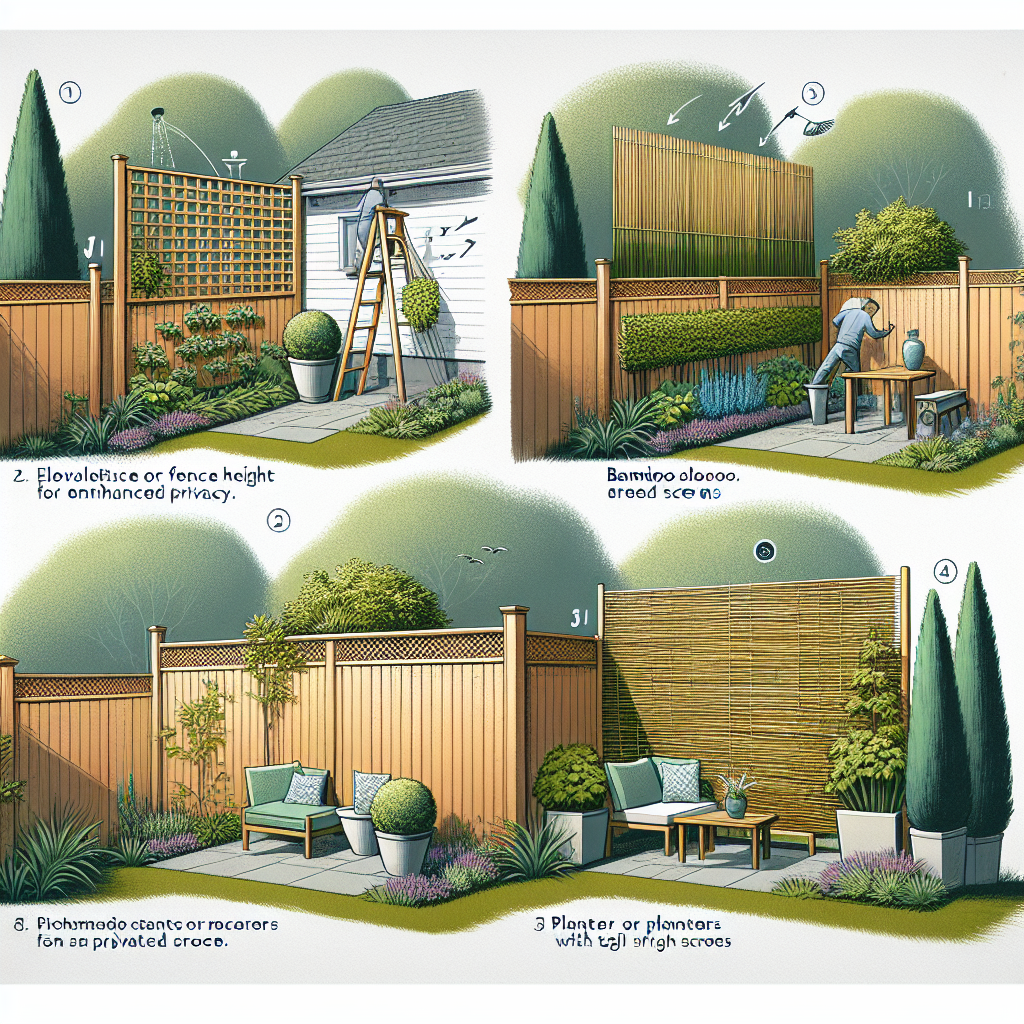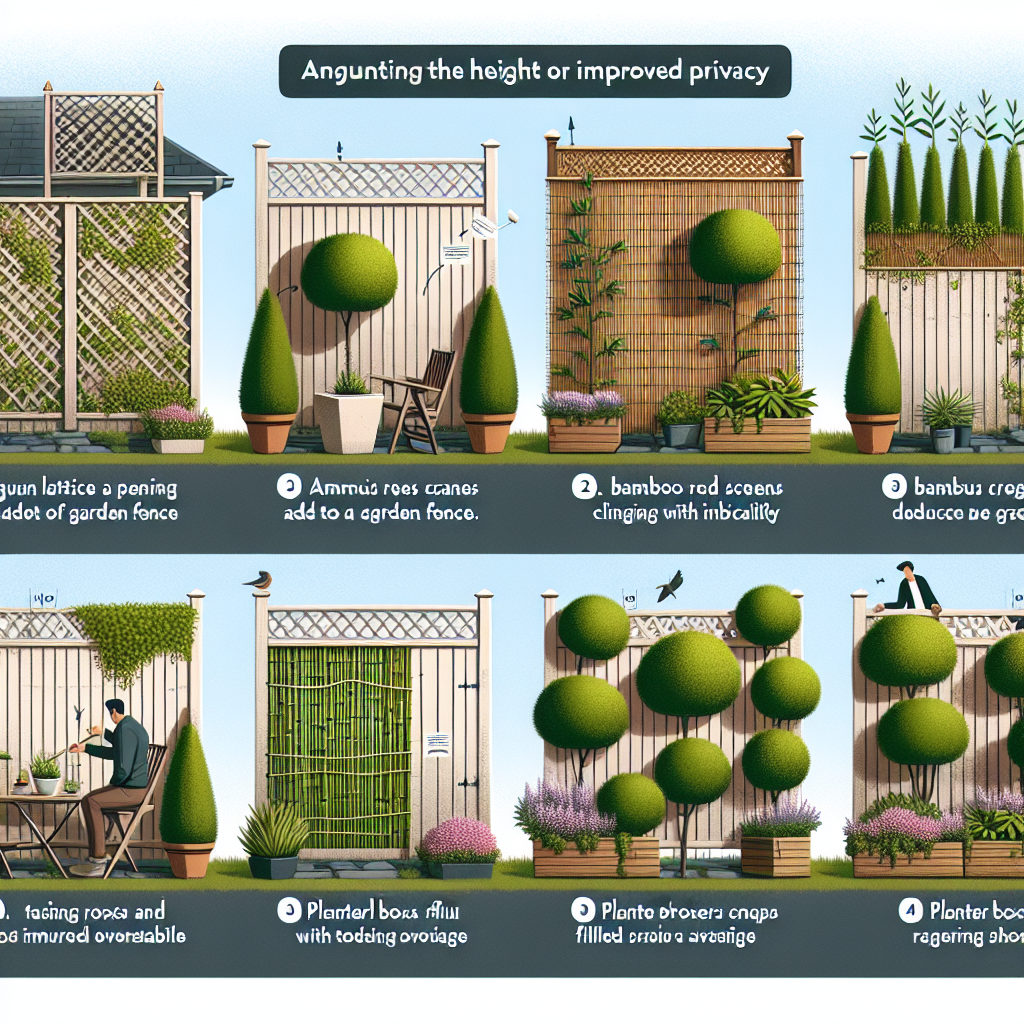Are you tired of feeling like you’re living in a fishbowl with no privacy? Well, fret not because we have the perfect solution for you! In this article, we will show you exactly how to make your fence taller to ensure maximum privacy in your outdoor space. Whether you want to keep prying eyes at bay, block out noise, or simply create a tranquil haven for yourself, we’ve got you covered. So grab your tools and let’s get started on transforming your fence into a fortress of solitude!
1. Assessing the Current Fence
Checking the Height and Materials
Before you begin making your fence taller for privacy, it’s important to assess the current state of your fence. Measure its height to determine whether it provides sufficient privacy or if additional height is needed. Take note of the materials used in the construction of your fence, as this will impact the methods you can use to increase its height. For example, adding lattice or privacy screens may be easier with a wooden fence, while installing bamboo fencing may require a sturdier base.
Determining its Stability
In addition to considering the height and materials of your fence, it’s crucial to evaluate its stability. A fence that is leaning or showing signs of damage may not be able to support additional height or modifications. Check for any loose or rotted posts, weak joints, or other structural issues. Addressing any stability concerns before proceeding with heightening the fence will ensure the durability and effectiveness of your privacy enhancements.
Identifying Gaps and Weak Points
To maximize the privacy provided by your fence, it’s important to identify any gaps or weak points where visual or physical intrusion may occur. Walk along the length of your fence and inspect it closely for any areas where there are significant gaps between the boards or panels. Look for places where the fence may be leaning or where there is damage that compromises its integrity. By addressing these gaps and weak points, you can enhance the overall privacy and security of your fence.
2. Choosing the Right Method
Adding Lattice
Adding lattice is a versatile method for increasing the height and privacy of your fence. Lattice panels can be easily attached to the top of your existing fence, giving it a decorative touch while creating an additional barrier for privacy. To add lattice, you will need to prepare the fence by ensuring it is structurally sound and free from any rotted or damaged sections. Measure and cut the lattice panels to fit the desired height, attaching them securely to the top of your fence. Finally, consider painting or staining the lattice to match the existing fence for a cohesive and aesthetically pleasing look.
Using Privacy Screens or Panels
Another effective method for making your fence taller for privacy is by using privacy screens or panels. These can be made of various materials, such as wood, vinyl, or metal, and come in a range of styles and designs to suit your preferences. Select privacy screens or panels that complement your existing fence, ensuring they are the appropriate height and width to provide the desired level of privacy. Attach them securely to your fence, making sure to follow the manufacturer’s instructions for installation.
Planting Tall Shrubs or Trees
For a natural and visually appealing way to increase the height of your fence, consider planting tall shrubs or trees along its perimeter. Select plants that are suitable for your climate and provide dense foliage to create an effective privacy barrier. Before planting, prepare the soil and dig planting holes at appropriate intervals along the fence line. Carefully place the shrubs or trees in the holes, ensuring they are properly supported and well-watered. Regularly care for and maintain the plants to promote healthy growth and optimal privacy.
Installing Bamboo Fencing
If you prefer an exotic and eco-friendly option, installing bamboo fencing can be an excellent choice. Determine the desired height and length of your bamboo fence and ensure the area is properly prepared for installation. Bamboo fencing typically comes in rolls that can be easily attached to your existing fence or structure. Secure the bamboo fencing to the fence using screws or zip ties, making sure it is aligned properly and reinforced for stability. Regularly maintain the bamboo by inspecting for any signs of damage or weathering and taking necessary steps to preserve its condition.
Utilizing Trellis Structures
Trellis structures offer a practical and aesthetically pleasing way to increase the height of your fence while incorporating climbing plants. Select a trellis design that complements your existing fence and provides the desired height. Position the trellis against the fence, ensuring it is securely anchored and placed at the desired height. Train vines or climbing plants to grow on the trellis, allowing them to create a natural privacy screen as they mature. Regularly maintain and prune the plants to encourage healthy growth and maintain the desired level of privacy.
Employing Retaining Walls
In certain situations, employing retaining walls can be an effective solution for increasing the height of your fence and providing enhanced privacy. Evaluate whether a retaining wall is necessary based on the specific terrain and landscaping of your property. Plan and design the retaining wall, taking into consideration factors such as materials, desired height, and drainage. Construct the retaining wall according to the established design, ensuring it is engineered to withstand any potential soil or water pressure. Consider adding decorative elements to the retaining wall to enhance its visual appeal and blend it seamlessly with your existing fence.

3. Adding Lattice
Preparing the Fence for Lattice
Before you can add lattice to your fence, it’s crucial to ensure that the fence is structurally sound and able to support the additional weight. Inspect the fence for any loose or damaged sections, and repair or reinforce them as necessary. Check that all posts are secure and in good condition. Additionally, clean the fence thoroughly to remove any dirt, debris, or old paint that may hinder the attachment of the lattice.
Measuring and Cutting the Lattice
Measure the width and height of the fence to determine the dimensions for the lattice panels. Use a tape measure to get accurate measurements, and calculate the number of lattice panels needed based on the desired coverage. Once you have the measurements, transfer them to the lattice panels and mark the cutting lines. Use a saw or appropriate cutting tool to carefully cut the lattice panels to size.
Attaching the Lattice to the Fence
After cutting the lattice to size, position it on top of the fence, aligning it properly. Use screws or nails to attach the lattice panels to the fence, making sure to secure them firmly. Start by attaching the corners and then add screws or nails evenly along the top and bottom of each panel. Depending on the size and type of lattice used, additional support may be needed in the form of wooden framework or brackets.
Painting or Staining the Lattice
To create a cohesive look, consider painting or staining the lattice to match the color of your existing fence. Choose a paint or stain that is suitable for outdoor use and compatible with the lattice material. Apply the paint or stain according to the manufacturer’s instructions, ensuring thorough coverage. Allow the lattice to dry completely before touching or placing any objects against it.
4. Using Privacy Screens or Panels
Selecting the Appropriate Privacy Screens or Panels
When choosing privacy screens or panels, consider factors such as material, design, and height. Select a material that is durable, weather-resistant, and complements the aesthetics of your existing fence. Determine the design that best suits your preferences, whether it’s a solid panel or one with decorative cutouts. Additionally, ensure that the height of the privacy screens or panels aligns with your desired level of privacy.
Attaching the Screens or Panels to the Fence
Once you have selected the appropriate privacy screens or panels, carefully position them against the fence. Use screws or nails to attach the screens or panels securely, following the manufacturer’s instructions for installation. Ensure that the attachments are evenly spaced and provide adequate support. Double-check that the screens or panels are aligned properly to maintain a uniform appearance.

